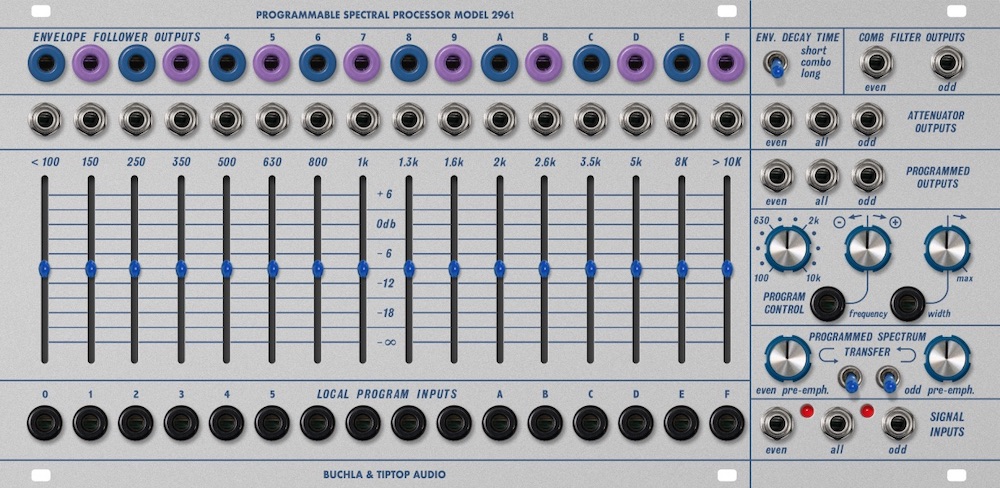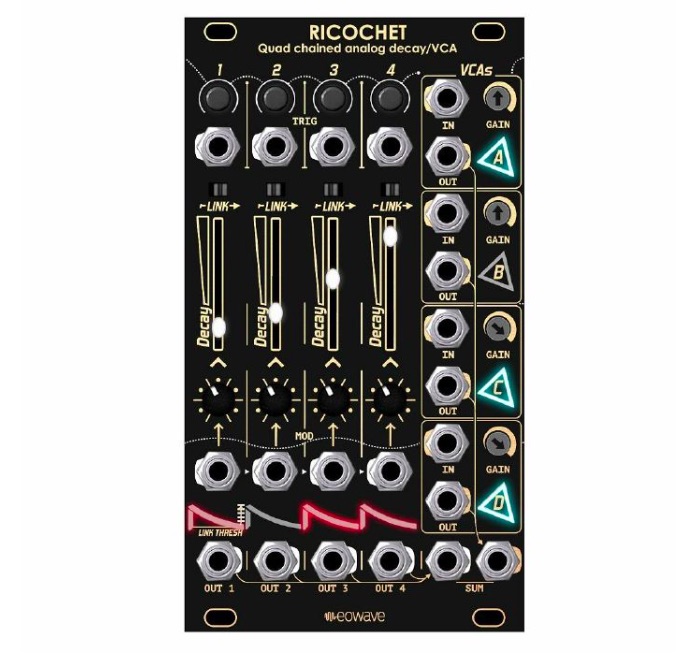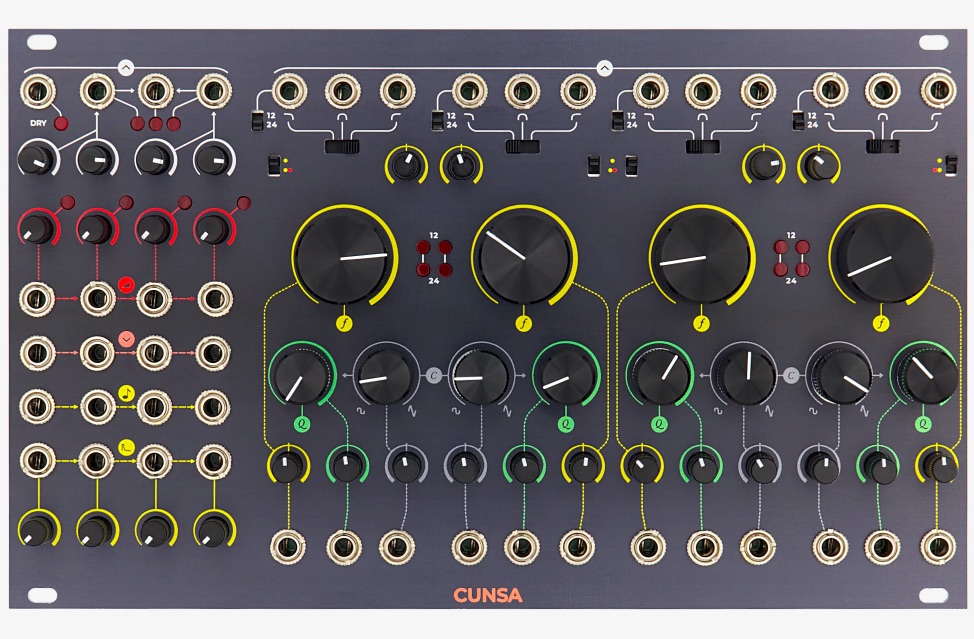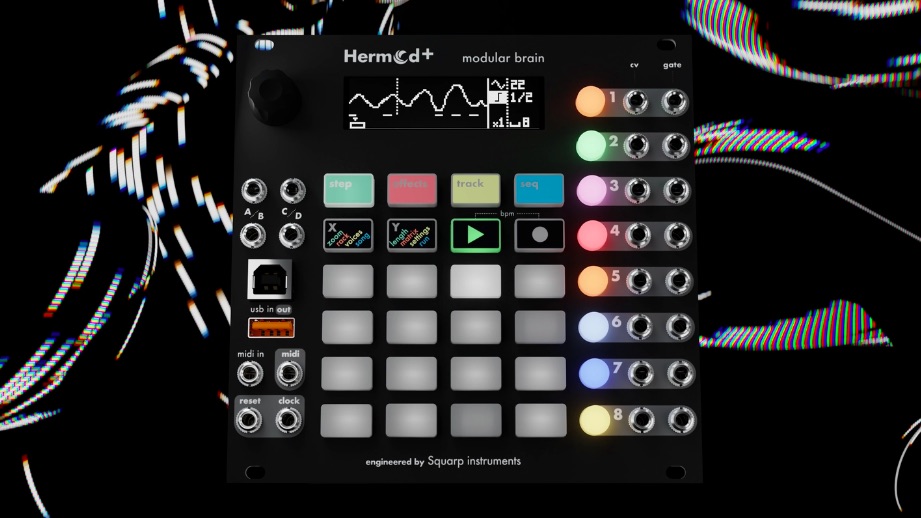January 2024 Eurorack round-up
This month’s best new modules include TipTop’s latest Buchla reissue, a unique quad envelope from Eowave and serious audio seasoning from Frap Tools.

Buchla & TipTop Audio Model 296t
TipTop Audio’s officially licensed Buchla modules have been some of our favourites over the last year. Bringing the iconic Buchla modules to a more accessible, Eurorack-compatible format was a master stroke, and there’s no doubt that classic west coast synthesis is more accessible than ever. The 296t is a Programmable Spectral Processor, based on the original Buchla 296 module from the late 70s. The 296 is effectively an array of 48 filters, combined into a 16-band format similar to a graphic equaliser. You can use it as an EQ by all means, but that’s only scratching the surface of what the 296 can do. Each band has its own envelope follower and VCA, but the 16 bands are also split into two banks of eight – odd and even frequency bands respectively – meaning that you can achieve a lot of different creative effects depending on how you approach this one.
Playing with the individual attenuator sliders is probably the best way to get started with the 296, if only to get to grips with how the frequencies have been tuned. This is effectively a graphic EQ routed to the Attenuator Outputs. Once you’re acclimatised to the basics of manual control, the Programmed Outputs are where things get more interesting. These work independently of the Attenuator Outputs, and are not affected by the sliders. Instead, the Program Control knob allows you to sweep manually through frequency bands (with CV control of frequency and width), while the Programmed Spectrum Transfer section allows you to apply the spectrum analysis from the even bands to the odd bands, or vice versa. There’s a lot to get to grips with – not to mention Local Program Inputs for independent CV control of each band – but there’s real depth for both hands-on twisting and CV-controlled dynamic manipulation of frequencies. By routing in a mic signal and an oscillator to the Signal Inputs, you can of course also use the 296t as an eight-band vocoder. For an even more elaborate approach, Buchla even suggest hooking two modules together for 16-band vocoding, with the envelope follower outputs from the mic analysis patched into the Local Program Inputs to modulate the oscillator signal.
The 296t represents the most expensive module in TipTop’s Buchla output so far. It’s big and it uses a lot of power. But this is a serious module, packing a huge amount of creative options for the money. Our first batch of these sold out before the time of going to press, but sign up for email alerts and you’ll be the first to know when more units arrive.

Eowave Ricochet
Eowave’s Ricochet is all about multiple stages of envelope generation rather than frequency bands. The Ricochet is a quad chained analogue envelope generator with VCAs and a built-in noise source, connected so that the end of each envelope triggers the start of the next. It’s hard to know exactly where to start here, as the Ricochet can be used in a number of different ways. Perhaps the easiest starting point is to use the internal noise source to set the module up as what you might describe loosely as a kind of ratcheting hi-hat sequencer. With different audio signals patched in, the Ricochet can become a more conventional envelope generator and drum shaper, a sidechain compression-style ducker, an envelope sequencer, a burst generator or various other creative tools. Certainly not a particularly conventional module, and arguably one which makes more sense hands-on than it does explained in writing, but an interesting approach which reaps good creative results.

Frap Tools Cunsa
Continuing this month’s theme of multi-part modules, the Frap Tools Cunsa is a quad analogue (or dual stereo) pingable/ringable multi-mode filter. Cunsa is a Modenese term for seasoning, and Frap explain that the module “can gently glue together a patch by applying a ‘final touch,’ or it can set it on fire with a ridiculous amount of spice. It’s up to you and your cooking style!” The filters are multimode resonant designs with saturation and feedback, linked via a series of semi-normalled inputs and grouped outputs, meaning you can use them as four separate circuits or in combinations. The most striking feature of the Cunsa is its ultra-minimalist user interface. There are only very basic text legends on the front panel, but once you get the hang of the options you discover incredible depth and lots of nice touches. Aside from the excellent sound of the filters themselves and the option to adjust the character of the saturation and distortion, there are some really clever features, such as the option to choose Combo mode for each filter, which links the cutoff frequency to the VCA input for a non-linear effect somewhat similar to a vactrol-based filter or low-pass gate. Similarly, the Ping circuit allows you to modulate the filters via a circuit in which rising CV inputs are almost instantaneous, but falling CV inputs are slew-limited and therefore slowed. With this definition of pinging already used, Frap also allow you to ‘ring’ a filter and push it into self-oscillation, which can be particularly effective given that the filters all track pitch CV accurately.
It’s worth mentioning that Frap have taken the highly unorthodox approach of documenting all of their modules in a single manualone (‘big manual’), which seems a bit odd at first but it’s well worth exploring its 131 pages, not just for explanations of the Cunsa features and potential applications, but also because there’s lots of good general discussion of modular synthesis to be found inside. Either way, though, the Cunsa is a powerhouse of colour and flavour, just as good for creating synth patches as processing existing sounds.

Squarp Instruments Hermod+
The updated Hermod+ is a fairly major overhaul of what was already a brilliant module. The interface has been updated substantially, for a start, with an improved screen, 4×4 pad matrix and dedicated clock and reset inputs. The overall concept remains broadly similar, with 16 tracks of sequencing power, set up in a way which is clearly designed to lend itself equally to studio programming, more freeform jamming and live performance alike. The eight CV/gate tracks can be switched to generate MIDI, while an additional eight dedicated MIDI tracks mean you have plenty of connectivity and the option to work with a mixture of monophonic or polyphonic patterns across the 16 tracks. Real-time non-destructive effects, automation and versatile modulation matrix allow you to manipulate sequences in real time as they play. Put simply, it’s an updated and improved version of one of the best Eurorack sequencers around.
Greg Scarth